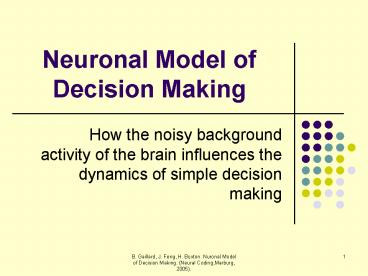Neuronal Model of Decision Making - PowerPoint PPT Presentation
1 / 26
Title:
Neuronal Model of Decision Making
Description:
Saccadic Eye. Movement. B. Gaillard, J. Feng, H. ... Embedded decision: Saccadic Eye Movement. ... They use a Saccadic Eye Movement. K and l are parameters. ... – PowerPoint PPT presentation
Number of Views:152
Avg rating:3.0/5.0
Title: Neuronal Model of Decision Making
1
Neuronal Model of Decision Making
- How the noisy background activity of the brain
influences the dynamics of simple decision making
2
Motivations/Overview
- Specific neurons involved in decisions. A
benchmark decision task about moving dots,
involving area LIP (Newsome and Shadlen, 2001 ). - Accumulation of evidence threshold decision
making (Smith and Ratcliff, 2004). - Dynamical models of decision through mutual
inhibition. (Wang, 2003, Amitt and Brunel, 1997). - Low level background activity of the brain
(Salinas, 2003). - A complete story from sensory inputs to the
movement that expresses the decision.
(Merleau-Ponty, ) - Second order statistics Gentz, Feng.
3
Network Connectivity
Upwards detector
E X C I T A T I O N
E up
I N H I B I T I O N
I down
I up
Downwards detector
E down
Saccadic Eye Movement
Background Activity
Kinematogram Stimulus
4
Integrate and Fire Model
- Membrane model
- Diffusion Approximation with Poissonian synaptic
inputs processes - The Variance of ISI is equal to its mean
- Activities of neurons characterised by FR
- r is the ratio between excitatory and
inhibitory inputs
5
Global Direction Detectors
6
Results of the Direction Detector
The Firing Rate of a directtion detector is a
linear function of the coherence of the
stimulus. Increasing r increases discrimination
accuracy. (Gaillard et al, 2005). Gaussian
distribution of ISIs Fits Biological data,
common approach in literature. (Wang, 2003).
7
LIP column where the decision takes place
Inh
E up
Background activity
Upwards detector
E down
Inh
Downwards detector
Inh
Exc
8
Weights Matrix
9
Embedded decision Saccadic Eye Movement.
In order to express the decision, any living
being has to make a move. For example, in
Newsomes experiments on monkeys, the monkeys
indicate their decision by moving their eyes in
one direction or another. They use a Saccadic Eye
Movement.
K and l are parameters. Fup and Fdown are the
forces applied to eye by the muscles,
proportional to the Firing Rate of the decision
neurons. The tangent function expresses an
elastic force, that prevents the eye position
from diverging. Same decision criterion as
psychophysical experiments.
10
Time course of a decision and working memory
11
Illustrating Movie
12
Simulations Results
- Influence of the FR (mean ISI) of the Background
Activity on Reaction Time
13
Simulations Results
- Influence of the Standard Deviation of the
Background Activity on Reaction Time
14
Simulations Results
- The Influence of the standard deviation of the
background activity on Error Rate
In the middle, there is the mean over all values
of the mean. Surrounded by two extreme cases.
15
Prediction Error Rate as a function of Reaction
Time
16
Partial conclusions
- Confirm that background activity controls RT, not
a switch, a continuum. - Not only the intensity of the background
activity, but also the actual noise reduces
Reaction Time. (And increases Error Rate). - A Non invasive idea for biological research
ERf(RT). - Non monotonous behaviour. Interpretation?
- Second order statistics are essential to the
system dynamics We cannot use the Poisson
assumption.
17
Propagation of Moments
- Usual Approximation Scheme for the Integrate and
Fire model
- Homogenous case with r inhibitory synapses for
one excitatory
18
Propagation of Moments
- Expressions of the first and second moment
19
Propagation of Moment
- Expression of the mapping
20
System Study
- Homogenous case.
- Two stable attractors quiet and high activity.
- If Inhibition stronger than excitation (rgt1), low
level activity attractor. - Our case is heterogeneous. We study the
generation of islands of higher activity within
the stable sea of low level activity. - Resort to simulations.
21
The mapping
22
No decision when small background variance.
23
Time course of a decision
24
Reaction Time depends on the moments of
background activity
25
Conclusions
- MNN results contradict Poisson model Detrimental
assumption. - The intensity of the background activity seems to
act like a switch, whilst the actual noise
controls Reaction Time as a continuum. (And
probably increases Error Rate). - Non monotonous behaviour.
- How to measure ER?
26
Some References
- 1 E. Salinas. Background Synaptic Activity as a
Switch Between Dynamical States in a Network.
Neural Computation, 15 1349-1475, 2003. - 2 N. Berglund and B. Gentz. Pathwise
description of dynamic pitchfork bifurcation with
additive noise. Probab. Theory Related Fields,
122(3)341388, 2002. - 5 M. N. Shadlen and W. T. Newsome. The Neural
basis of a perceptual Decision in the Parietal
Cortex (Area LIP) of the Rhesus Monkey. J.
Neurophysiology, 86 1916-1935, 2001. - 6 E. P. Simoncelli and D. J. Heeger. A model of
neuronal responses in visual area MT. Vision
Research, 38743761, 1998. - 7 X. J. Wang. Probabilistic decision making by
slow reverberation in cortical circuits. Neuron,
36955968, 2002. - 8 D. J. Amit and N. Brunel. Model of global
spontaneous activity and local structured
activity during delay periods in in the cerebral
cortex. Cereb Cortex 7, 237-252, 1997. - 10 P.L. Smith and R. Ratcliff. Psychology and
neurobiology of simple decisions. Trends in
Neuroscience 27(3), 161-168, march 2004. - 11 B. Gaillard and J. Feng. Modelling a visual
discrimination task. Neurocomputing,
65-66203209, 2005.































